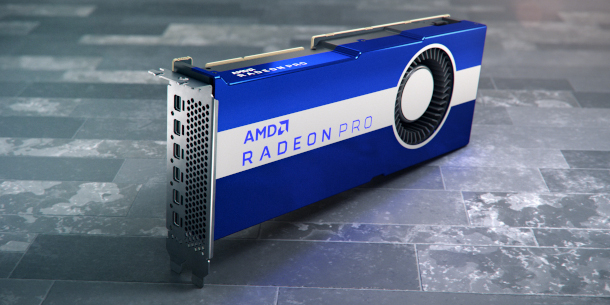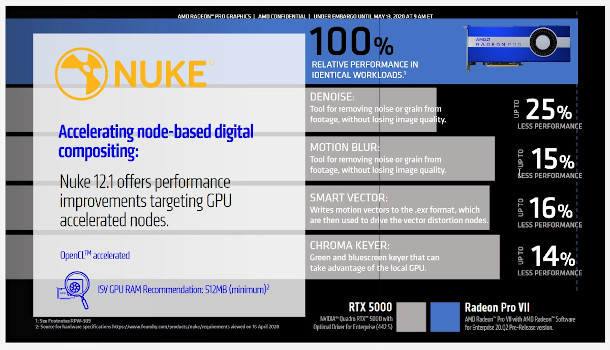AMD unveils Radeon Pro VII and Infinity Fabric Link Bridge

AMD has unveiled the $1,899 Radeon Pro VII, a new high-end card in its Radeon Pro series of workstation GPUs, aimed at media and entertainment, engineering simulation and high-performance computing work.
Like AMD’s previous top-of-the-range card, the Radeon Pro WX 9100, it features 16GB of HBM2 memory, but has a much higher memory bandwith and FP64 compute performance.
The firm is pitching the card as a cost-effective alternative to Nvidia’s Quadro RTX 5000 for media work.
AMD has also announced a $199 Infinity Fabric Link Bridge, which will enable users to pool GPU memory between two Radeon Pro VII cards installed in the same machine.
Similar specs to 2017’s Radeon Pro WX 9100, but higher memory bandwidth and FP64 performance
The workstation counterpart to last year’s Radeon VII gaming GPU, the Radeon Pro VII succeeds the older Radeon Pro WX 9100 at the top end of AMD’s Radeon Pro product line.
Its core specs are pretty similar to its predecessor: 16GB of HBM2 memory, 13.1 Tflops of single-precision (FP32) compute performance, and six display outputs.
The key changes are the memory bandwith – at 1,024 GB/s, more than double that of the WX 9100 – and the dual-precision (FP64) compute performance of 6.5 Tflops: over eight times that of the WX 9100.
New Infinity Fabric Link Bridge lets two Radeon Pro VIIs pool GPU memory
In addition, the new Infinity Fabric Link Bridge – AMD’s equivalent to Nvidia’s NVLink Bridge – means that users can pool GPU memory between two Radeon Pro VIIs installed in the same machine.
That means a shared memory pool of 32GB, making it possible to process much larger scenes purely on the GPU, avoiding the performance hit that usually results from having to shuttle data between CPU and GPU.
Users will be able to install the Infinity Fabric Link Bridge in two-slot or three-slot configurations, although only with the Radeon Pro VII: it won’t be compatible with older Radeon Pro cards.

A cost-effective alterative to Nvidia’s Quadro RTX 5000 for media work?
In the media and entertainment market, AMD is pitching the Radeon Pro VII as a more cost-effective alternative to Nvidia’s $2,299 Quadro RTX 5000.
AMD’s benchmark tests, reproduced above, suggest that the Quadro RTX 5000’s performance in Nuke is 14-25% lower than that of the Radeon Pro VII for GPU-accelerated tasks like keying and denoising.
The firm’s other benchmarks show smaller performance benefits for the Radeon Pro VII for colour grading and applying effects in DaVinci Resolve, and marginal performance benefits in Photoshop.
Clearly, those are benchmarks that AMD itself has selected, so it will be interesting to see if the results are replicated in independent tests.
For DCC work, it is also worth noting that on Windows and Linux, most of the major render engines used in production – Blender’s Cycles and AMD’s own Radeon ProRender notwithstanding – require Nvidia cards for GPU rendering, as do the new hardware-accelerated ray tracing systems in Unreal Engine and Unity.
Pricing and availability
AMD’s Radeon Pro VII is due to ship in mid June 2020, with an MSRP of $1,899. The Infinity Fabric Link Bridge has an MSRP of $199.
Read full specifications for the Radeon Pro VII on AMD’s website
